Becoming An Herbalist: Juliet Blankespoor’s Dance With The Plants
Written by Juliet Blankespoor
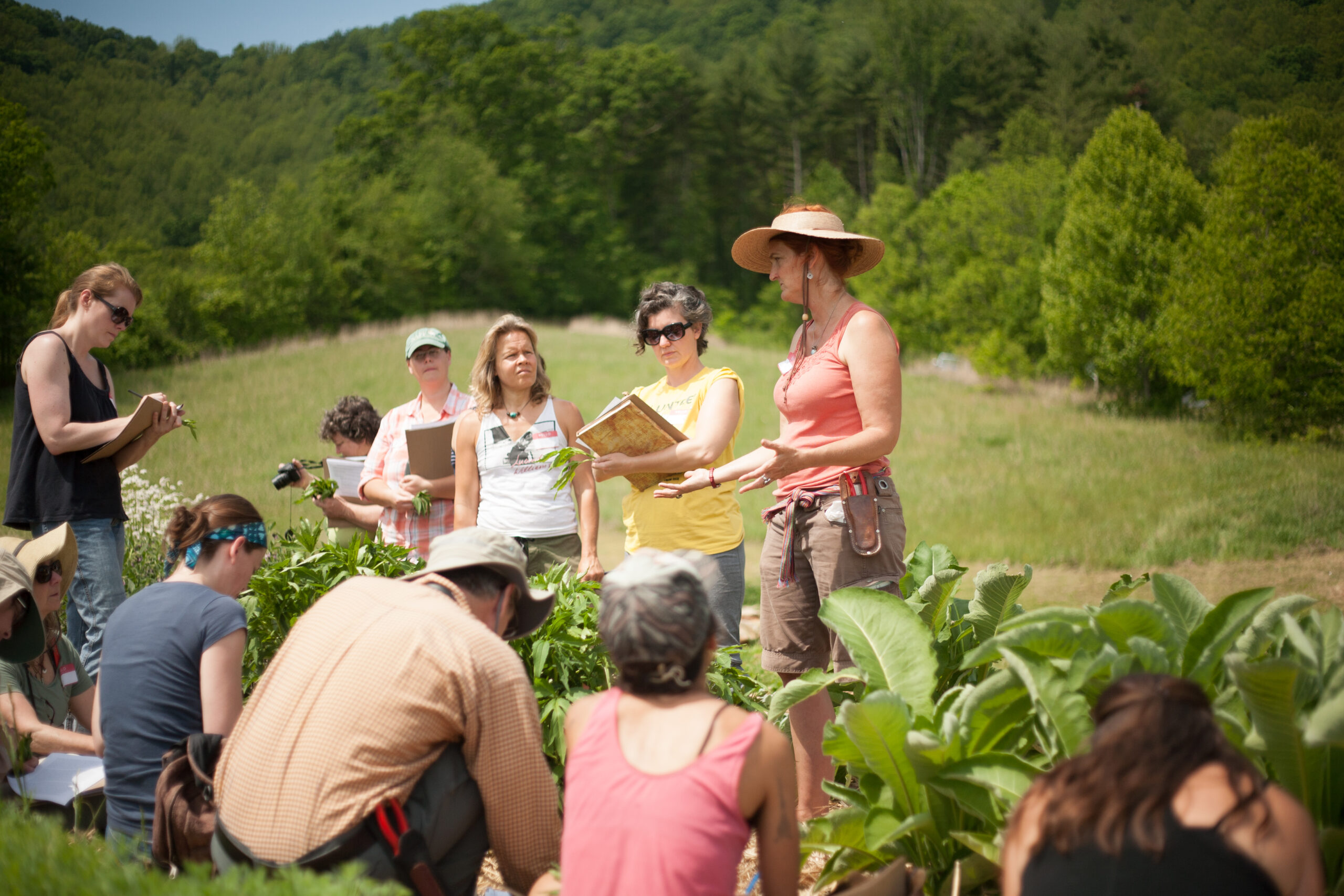
Juliet Blankespoor teaching medicinal herb gardening at her farm in NC. Photograph by Emily Nichols.
If you’re reading this, perhaps you’re wondering how to become an herbalist. Or maybe you’re wondering if an herbal career is right for you or what an herbalist even does. “What is the best way to train as an herbalist?” is one of the most common questions I receive. Perhaps you love herbs but don’t necessarily want to enter the field of botanical medicine. You’re smitten with healing plants and want to learn about their culinary and therapeutic uses, and you’re looking for safe and natural alternatives to pharmaceuticals. And then again, maybe you’re like me and are simply interested in other people’s stories.
There’s no one way to immerse yourself in the field of herbal medicine, which is why I created the most extensive resource for anyone interested in becoming a professional herbalist. Grab a free copy of How to Start Your Herbal Career: The Ultimate Guide for Budding Herbalists, and then pull up a chair to read more about my transformation from herbal illiteracy to the founder of one of the leading schools in herbal medicine. For my herb-curious friends: the guide is something you’ll want to keep in your back pocket, as it links to my favorite herbal resources: books, conferences, organizations, and suppliers.
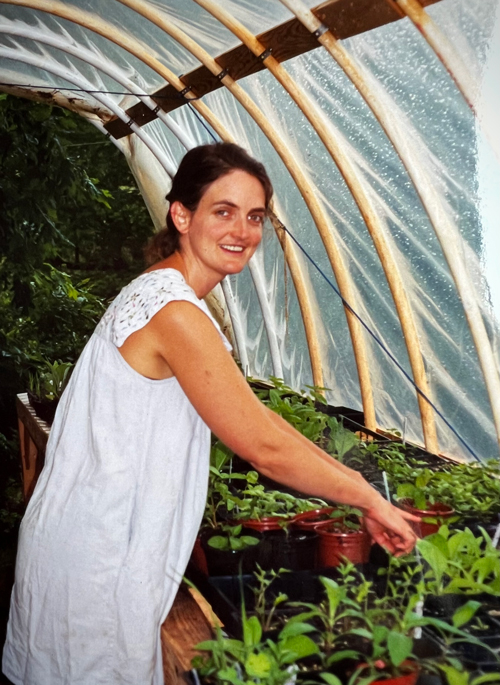
How I Trained as an Herbalist
My infatuation with herbal medicine started when I left my childhood home and found a kindred community of earth lovers and environmental activists. Many of my new friends were botanically beguiled, and I quickly caught the plant bug. I switched my major from languages and formally began to study botany. Stamens, stigmas, and anthers were my first dates in what would become a lifelong love affair with plants. Today, I plan my vacations around botanical gardens and keep random pieces of colorful bark in my pocket in case I need an icebreaker in an awkward social situation. Three decades into this journey as a plant–human matchmaker, I’ve owned almost every herbal business you can imagine: an herbal nursery, a medicinal products business, a clinical practice, and now an online herbal school specializing in bioregional, hands-on herbalism.
But I wasn’t always so inclined. As a child, I was an introverted bookworm who loved the solitude and magical freedom of the woods but had zero interest in plants. I was very close to my grandpa Joe (Joachim Naphtali Simon), an eccentric intellectual who was a vegetable gardener and a naturalist. On his own initiative, Grandpa Joe labeled all the trees—with their common and scientific names—that grew on the trail that led home from our school so all the kids could learn them. My Dutch dad—also an avid gardener—and my Grandpa both tried to rope me into gardening, to no avail.
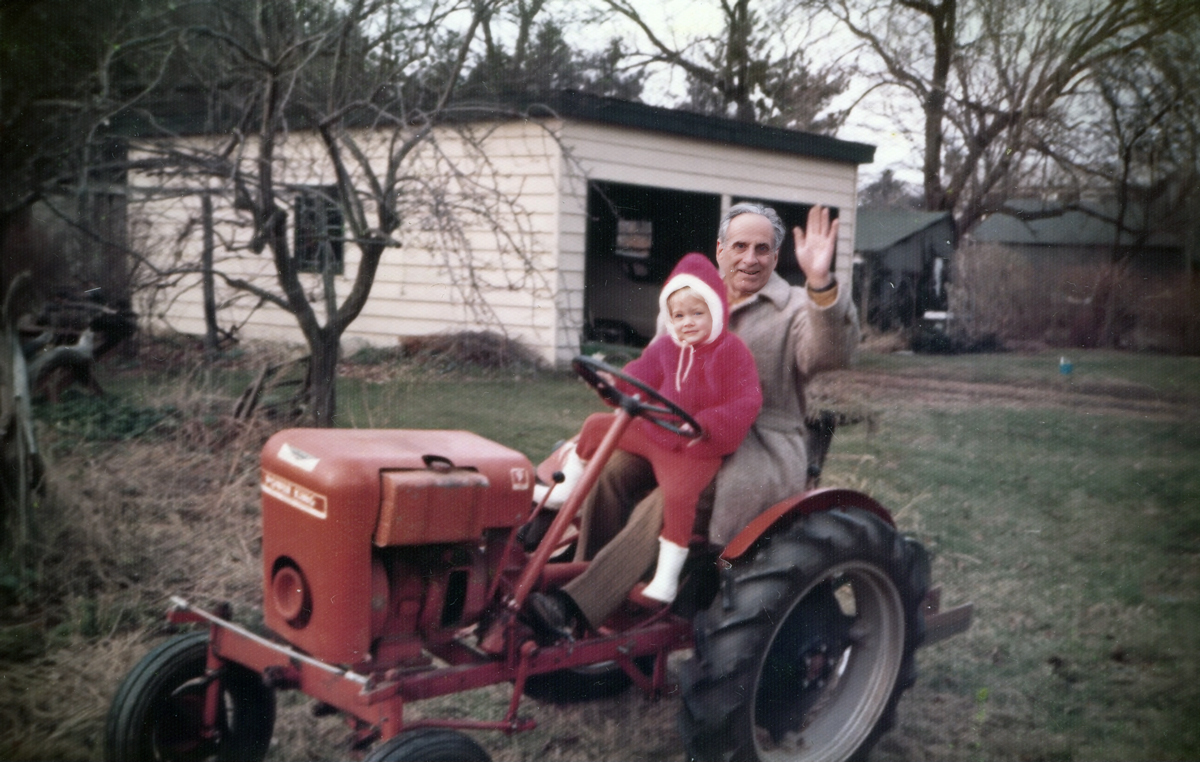
Grandpa Joe and wee Juliet displaying her first signs of hypervigilance (safety first!) on his farmette in Long Island, NY. Photograph by Joanna Simon.
Luckily, the seeds they planted sprouted when I left home and learned about the environmental crisis, organic gardening, and plant medicine. I suddenly wanted to learn everything I could about plants. My conversion resulted in complete botanical bewitchment. I built my first garden—a monumental flop on all counts but one that nonetheless filled me with pride and joy. I was now a gardener, even if I didn’t yet have a green thumb. This burgeoning love of plants was my saving grace: my passion for herbs blossomed at a low point in my life when I was consumed with self-doubt and felt lost and alone in the world. My kinship with plants filled me with connection, purpose, and belonging.
Lest you think my journey toward becoming an herbalist was all about the plants, let me assure you it also included those who taught me about them. For starters, my botany professor at the University of Florida, Dr. Terry Lucansky, encouraged me to pursue a career in science and showed me the magic of microscopic plant anatomy. Under his tutelage, I went on to earn my botany degree in the early 1990s.
Meanwhile, I picked up the few herbal books I could find at the local bookstore (this was three decades ago—there was no internet and very few herbal teachers or authors) and started learning about growing and gathering herbs. I’d learn about a plant in a botany class, and, recognizing the scientific name from one of my herbal books, I’d furiously ride my bike home to devour everything I could find about the herb in those tattered pages.
One day, in my native plant identification class, my professor introduced me to the herb bayberry. In my after-school research, I learned the root bark was the medicinal part of the plant. Root bark? I had no idea roots even had bark! So, I pulled out a shovel and dug up the plant’s roots to see for myself. I experimented with decoctions of the bark whenever my friends got the sniffles or had a sore throat. In this fashion, I learned how to make medicine and harvest plants (I had proper identification on my side from my university botany studies—safety first, friends, always!).

Three generations in a long lineage of herbalists: from left to right: Chelsea Gomes, 7Song, and Juliet Blankespoor. Photographer unknown.
After years of self-study and botany classes, I finally found a real, live herbalist: 7Song became my first plant medicine teacher. He ran an off-the-grid herbal school out of his tiny cabin in Ithaca, New York. I felt a natural affinity for his hands-on approach to herbal medicine, which focused on using local, abundant plants. (Plus, he has a wicked sense of humor and an encyclopedic plant brain.)
I went on to study clinical herbalism with James Snow in California. Then, after a brief fling with seaweed on Orcas Island in Washington State, I sat at the feet of the late Michael Moore (the herbalist, not the filmmaker) in Bisbee, Arizona. Michael was a central player in the resurgence of herbalism among white healers in the 1970s and 1980s (many Black and Indigenous communities never stopped using herbs and thus didn’t experience a “resurgence” because they had intact lineages and living knowledge). He passed on in 2009, but his legacy lives on in his irreverently hilarious and informative books on Western herbs.
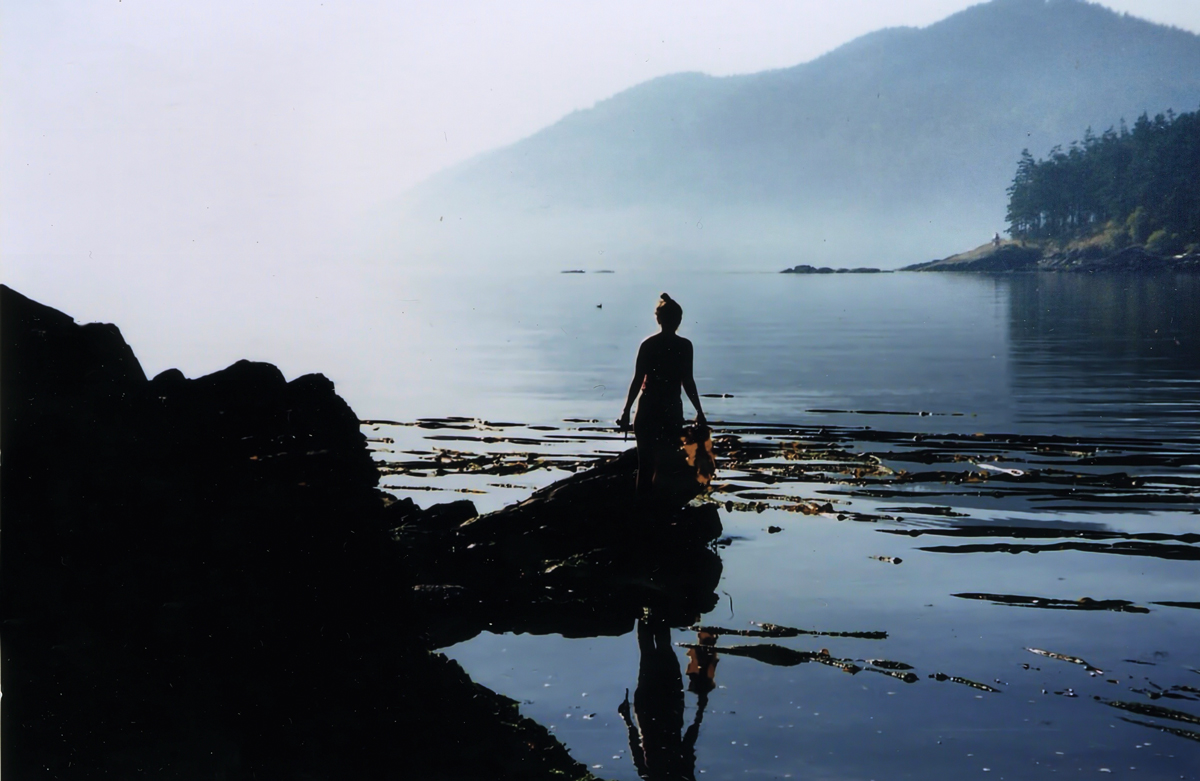
Juliet harvesting fresh seaweed on Orcas Island, Washington. Photograph by Kalinda.
Michael learned about the traditional uses of Southwestern plants from Indigenous and Latinx village healers, whose practice centers on local remedies. He also extensively studied the works of the Eclectics, an influential group of herbal physicians in North America who flourished in the late 19th and early 20th centuries. The Eclectic materia medica (study of each herb’s therapeutic uses) is rooted in the knowledge of European herbalists—both studied and folkloric—and Indigenous and Black healers from North America. Much of the information in the earliest herbal books—primarily written by white men—has extensive roots in the traditional knowledge of Black, Indigenous, and white folk healers, often women.
Shortly after Michael Moore died, I dreamed that my apprentices and I took some of his old musty herbal books (Michael collected historical herbals), tore the faded pages free from the failing binding, and placed them into the fresh soil of a newly dug garden bed. My dream-self knew the pages would nourish the herbs we would plant in the garden, and then I would teach about those herbs to my students. And so the lineage lives on in thousands of gardens and medicine cabinets—maybe even yours!
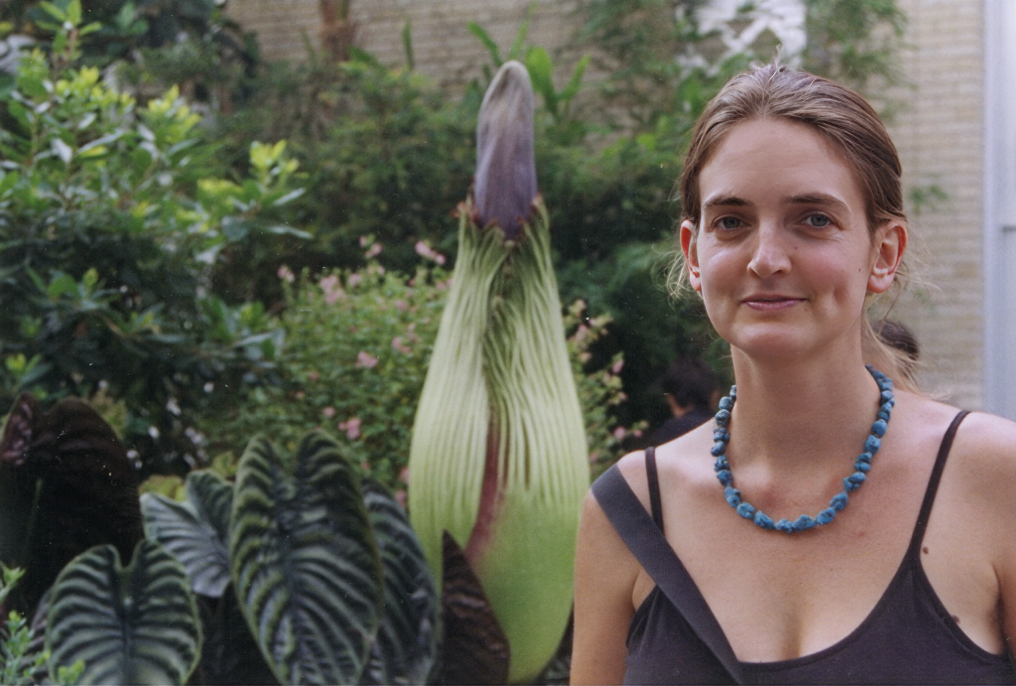
A Titan Arum inflorescence and adoring consort. United States Botanic Garden. Photograph by Joanna Simon.
Free Ways To Become an Herbalist
On my path to becoming an herbalist, I found enterprising ways to study herbal medicine without money. I volunteered at herbal conferences in exchange for complimentary attendance. Flashcards were my constant companions, helping me to memorize the scientific names of herbs and anatomy and physiology. I made flashcards for herbal actions and all the systems of the body. When I wasn’t quizzing myself on paper, I would go to plant nurseries and quiz myself on herbal plant identification. Pulling out a potted herb, I would guess its identity and check the plant tag to see if I got it right. Similarly, I spent days at botanical gardens (many are free to the public) learning to recognize medicinal plants.
In my twenties, I chose to live simply so I could spend my days doing what I loved. This was a privilege afforded me by my health, community, lack of caretaking responsibilities, and a host of factors I hadn’t earned. I was blessed by the plenty of the land and learned how to grow and gather food and medicine. My homes included a tent, the back of my pickup truck, a refurbished chicken shack, and structures inspired by Indigenous ingenuity (a teepee and wigwam).

Juliet drying seaweed in Port Townsend, Washington. Photographer unknown.
During this time, I spent many days at the library (electricity, running water, and air conditioning, oh my!) reading gardening and botany books and taking copious notes. I checked out every herbal book I could get my hands on. Reading was one of my favorite pastimes without the Internet, cell phones, or television. In full transparency, I now enjoy piping hot baths, sleep on a king-sized bed in a bonafide bedroom, and enjoy a Netflix binging session now and again.
I spent the growing season gardening or harvesting herbs, mushrooms, or seaweed when I wasn’t studying or reading. I learned most of my herbal knowledge and lore from my teachers and books, but these hands-on endeavors were invaluable (and my idea of a good time!). So, when I felt ready to teach, I wanted to do so through hands-on instructions. My school got its start as an herbal apprenticeship. My herbal apprentices would work in my gardens, herb nursery, and apothecary one day a week. Then I would take them out into the woods another day and teach them botany, herbal uses, sustainable wildcrafting, and plant and mushroom identification.
This exchange was tremendously beneficial, as I didn’t have the money to pay workers, and I gained valuable experience as an herbal educator. Plus, my daughter was a baby and accompanied us on all our adventures. Spending time with her when she was so young was especially important to me. I had one of those ginormous baby backpacks which could hold her and her cloth diapers, along with all my plant identification books.
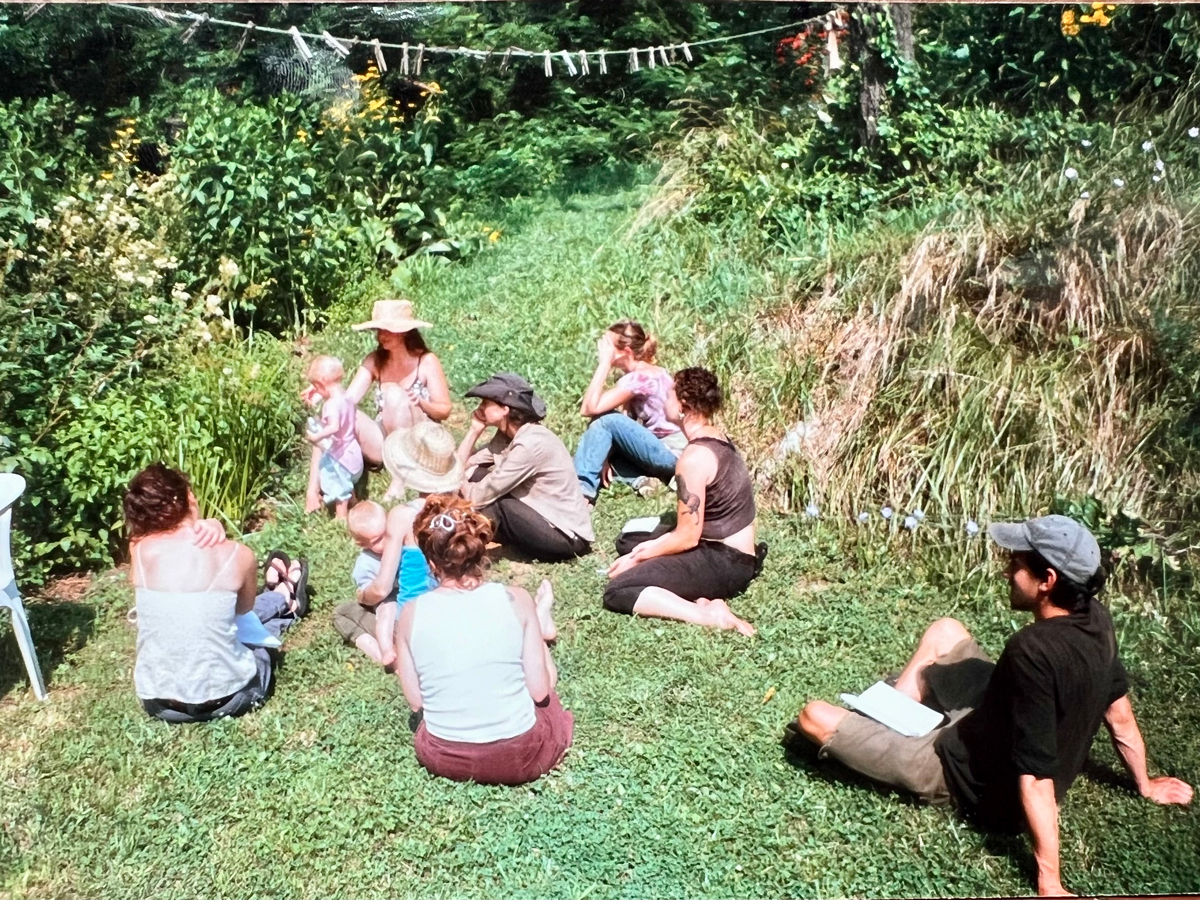
Juliet and toddler Ruby teaching their first cohort of apprentices in Leicester, NC. Photographer unknown.
Eventually, this arrangement transitioned into an official business when I started my herbal medicine school. But I always accepted five apprentices every year who attended classes for free in exchange for their help. Now that the Chestnut School of Herbal Medicine is entirely online, we offer need-based scholarships for social change and environmental healing. Since we started offering online courses in 2016, the Chestnut School has awarded more than $744K in scholarships to 400+ herbalists worldwide. Our scholarship participants are primarily people who identify as BIPOC (Black, Indigenous, and People of Color) and LGBTQ+ (Lesbian, Gay, Bisexual, Transgender, Queer or Questioning, Plus)—from which many Western herbal practices and medicines are derived and who have all too often lacked representation in contemporary herbal settings. People with disabilities, immigrants, refugees, and veterans also participate in our scholarship program.
There are infinite ways to study herbal medicine that don’t involve money. If you’re interested in more free ways to become an herbalist, please check out Free Ways to Become an Herbalist: 17 Resources for Training as an Herbalist.
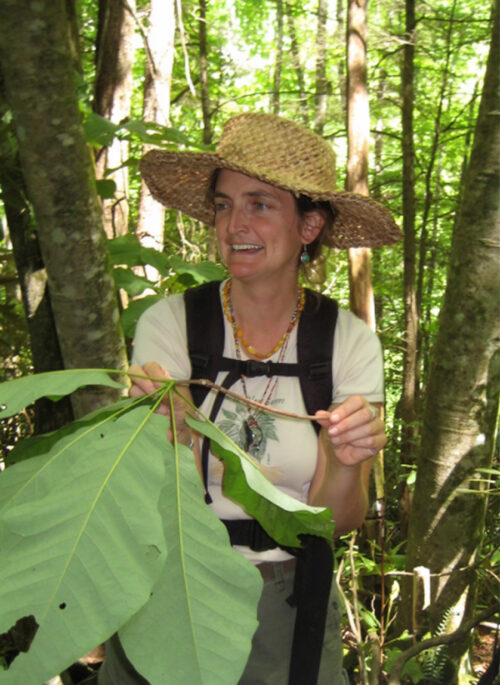
Herbal Careers: A Legacy of Botanical Medicine
In 2007, after years of studying herbal medicine and botany, I founded the Chestnut School of Herbal Medicine. I spent a decade teaching all-outdoor herbal programs focusing on bioregional herbalism: plant identification, harvesting plants, growing medicinal plants, and medicine making. Today the school is online, with thousands of students learning to become herbalists.
My next project was the Chestnut Herb Nursery, an organic medicinal plant nursery. Every spring, we grew tens of thousands of herb babies, which taught me about plant propagation and controlling plant diseases and problem insects. We painstakingly recorded our nursery statistics—successes and failures—which informed the technical propagation data I included in my online herbal courses and my first herbal book (more on that later).
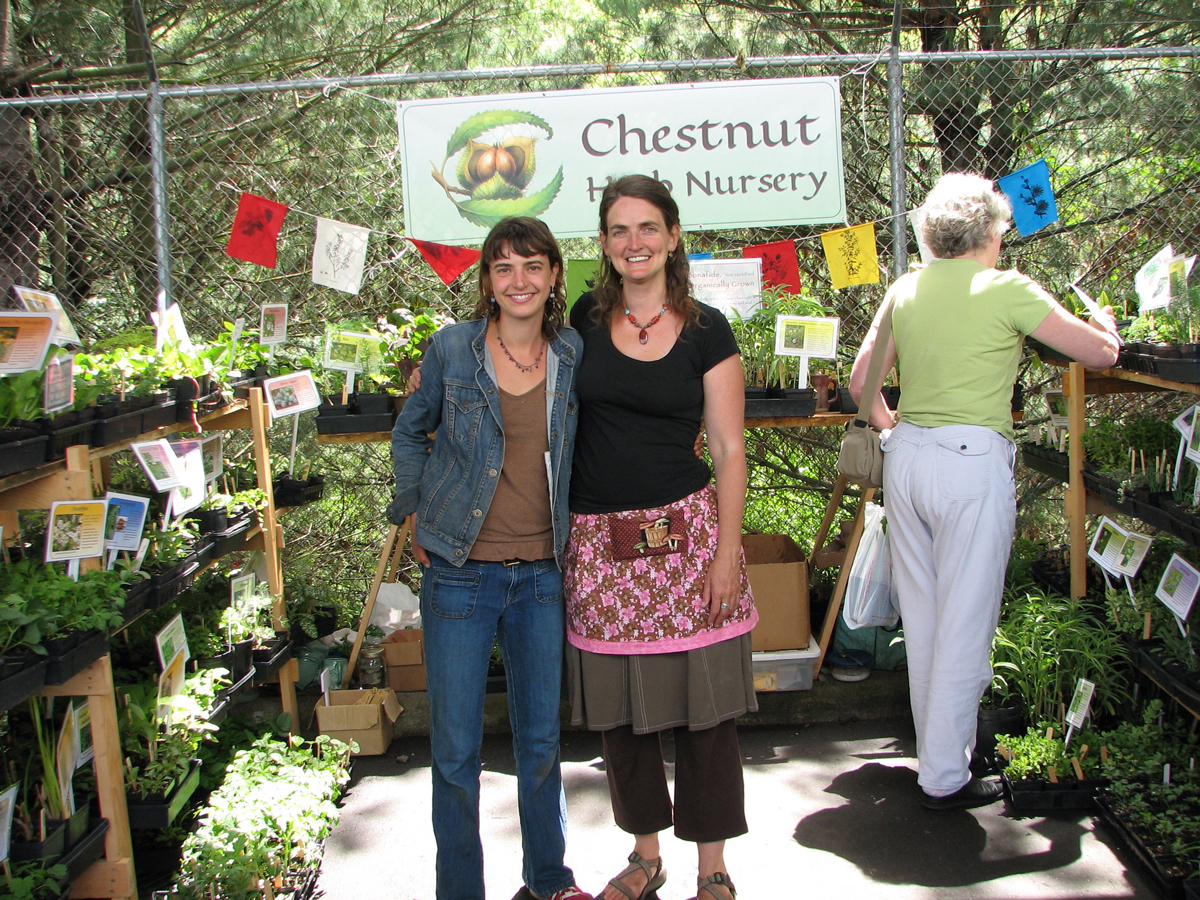
Juliet and Sarah Stokes, the Chestnut Herb Nursery manager, selling herbs at the Asheville Herb Festival. Photographer unknown.
Our graduates at the Chestnut School of Herbal Medicine are carrying forth the legacy I dreamt of years ago through their herbal businesses. Our programs showcase the many ways to become an herbalist to inspire our students. Some create their own herbal business, and others embark on an herbal career with an established company. Our graduates include entrepreneurs who own herbal stores or organic medicinal herb farms. Others are teachers or writers in the herbal field. Many Chestnut School of Herbal Medicine alumni are herbal practitioners, including massage therapists, physicians, and nurses who incorporate botanical medicine into their areas of expertise. One of the most common careers our students pursue involves making and selling herbal products in their bioregional apothecaries.
If you’re interested in studying with me and an array of gifted instructors, we offer numerous exciting online opportunities to learn herbalism, including the Herbal Medicine Making Course, the Foraging Course: Edible and Medicinal Wild Herbs, and the Herbal Immersion Program.

Juliet and her students on a camping field trip along the Suwannee River in Florida. Photographer unknown.
The Healing Garden: Cultivating & Handcrafting Herbal Remedies
Around the same time I formed the school, I acquired my first camera and learned to use computers and type (I didn’t want much to do with technology in those early years). I started writing and photographing for my blog Castanea and herbal publications; these creative pursuits lit the fire for my first book, The Healing Garden.
In 2022, I wrote The Healing Garden: Cultivating & Handcrafting Herbal Remedies. This book is the convergence of everything I’ve learned on my path to becoming an herbalist: the knowledge I learned from my teachers and the experience I gained through my herbal endeavors are infused into its pages. I started my herbal journey as a medicine maker and owned an herbal products line featuring homegrown and sustainably wildcrafted herbs for nearly a decade. My love for medicine-making and healing food is woven into the pages of a chapter on Preparing Botanical Medicine and Healing Food.
If you’re curious about becoming an herbalist, The Healing Garden is your gateway to growing a lush herbal paradise and crafting a pantry full of homegrown herbal remedies and concoctions. You’ll learn how to grow herbs from seeds, cuttings, and root divisions, including nurturing plants through the seasons right up to harvest. You’ll learn how each botanical can be harvested and brought into the kitchen and medicine cabinet.
By growing the botanicals in my book, I know you’ll make lifelong herb friends, and your life will be richer, your health more vibrant, and your gardens more spectacular.
Community Herbalists and Herb Gardeners
I wrote The Healing Garden for aspiring and community herbalists who want to grow their own medicine in their garden or even on the porch or patio. It’s equally helpful for the home vegetable gardener who wants to branch out to herbs and for homesteaders and permaculturists striving for greater self-sufficiency. Even skillful herbalists will find value in these pages, which are sown with seeding charts, propagation techniques, and sumptuous recipes.
You’ll come away with an intimate knowledge of more than 30 medicinal herbs, having learned precisely how to grow and harvest each one. If you’re new to gardening or don’t feel like you have a “green thumb,” take heart—you can learn to grow herbs! Gardening is a skill that anyone can pick up. Start small and visit your garden daily so your herbal charges are on your radar. You’ll make mistakes, but these will only serve to make you a more skillful gardener. You’ll be rewarded with the sweetest bounty: empowerment, plant friendships, a beautiful garden, greater health, and a cabinet full of potent medicine.
You can order a copy of The Healing Garden wherever books are sold. Once you have a receipt, you can sign up for a set of exquisite bonuses accompanying the text. To learn more about the book and the extras, visit The Healing Garden Gateway.
May your gardens grow you, and may your connection with the earth deepen through kinship with healing plants!
Meet The Green Mastermind Behind Blog Castanea
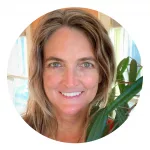
JULIET BLANKESPOOR is the founder, primary instructor, and Creative Director of the Chestnut School of Herbal Medicine, an online school serving thousands of students from around the globe. She's a professional plant-human matchmaker and bonafide plant geek, with a degree in botany and over 30 years of experience teaching and writing about herbalism, medicine making, and organic herb cultivation. Juliet’s lifelong captivation with medicinal weeds and herb gardening has birthed many botanical enterprises over the decades, including an herbal nursery and a farm-to-apothecary herbal products business.
These days, she channels her botanical obsession through her writing and photography in her online programs, on her personal blog Castanea, and in her new book, The Healing Garden: Cultivating and Handcrafting Herbal Remedies. Juliet and her family reside in a home overrun with houseplants and books in Asheville, North Carolina.
Interested in becoming a contributor?
© Chestnut School of Herbal Medicine and chestnutherbs.com, 2011-2023. Unauthorized use and/or duplication of this material without express and written permission from this site’s author and/or owner is strictly prohibited. Excerpts and links may be used, provided that full and clear credit is given to Chestnut School of Herbal Medicine and chestnutherbs.com with appropriate and specific direction to the original content.
Want to take a deeper dive into medicinal herbs and their uses?
Our 1,000-hour Herbal Immersion Program is the most comprehensive handcrafted online herbal course available, covering botany, foraging, herb cultivation, medicine making, and therapeutics.
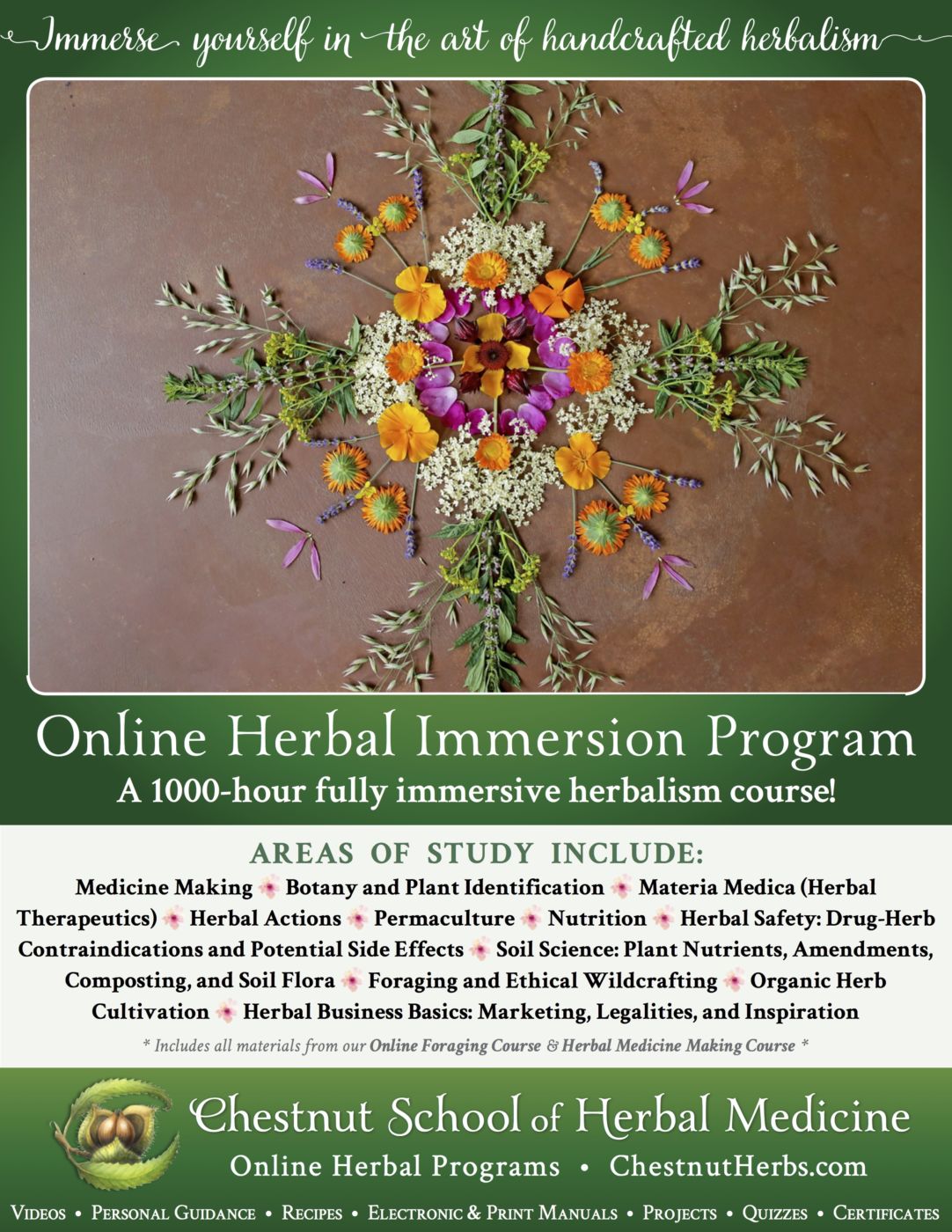
The post Becoming An Herbalist: Juliet Blankespoor’s Dance With The Plants appeared first on Chestnut School of Herbal Medicine.
Leave a Reply